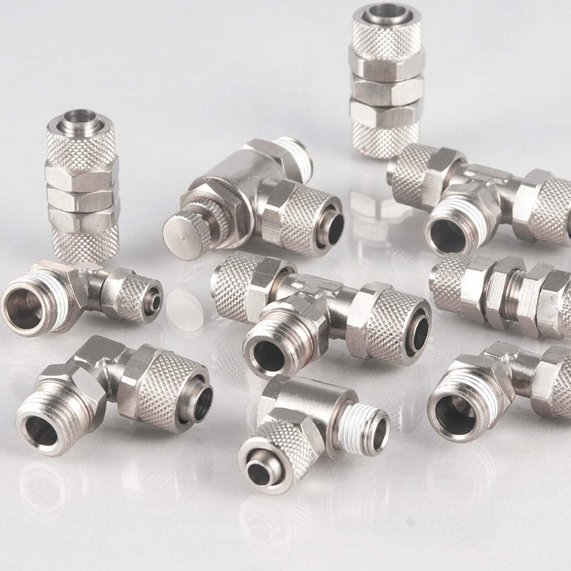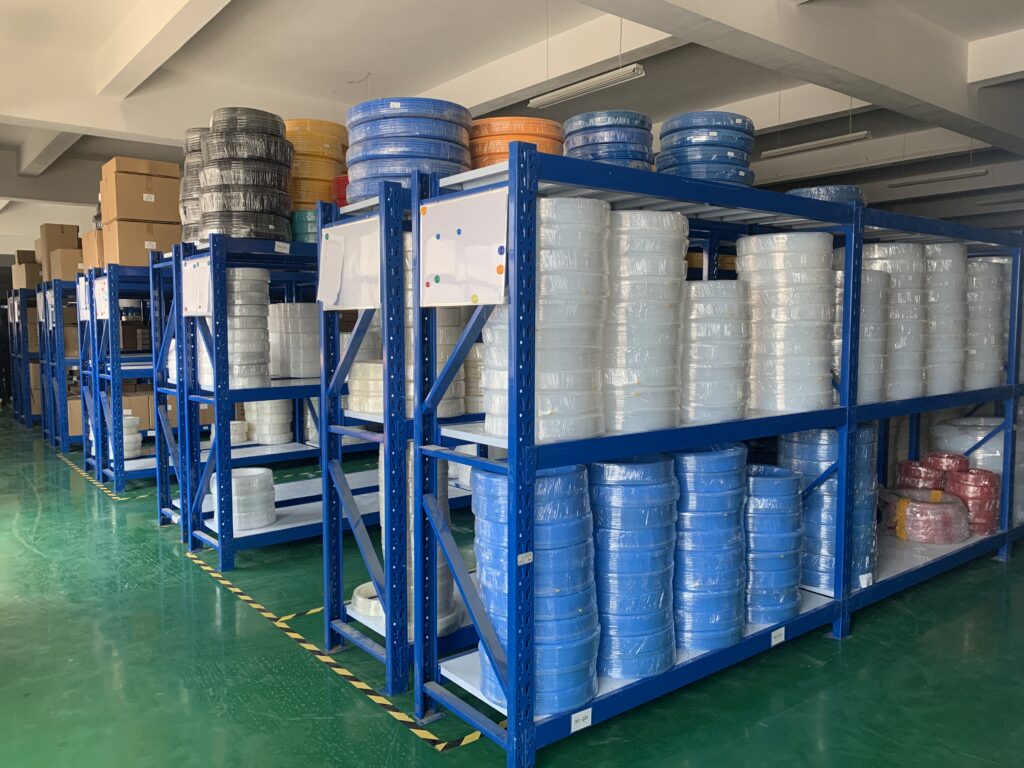Introduction
Air line fittings are the unsung heroes of pneumatic systems, playing a pivotal role in ensuring that compressed air flows seamlessly through various components. These fittings are not just connectors; they are essential for maintaining system efficiency, reliability, and safety. Selecting the right air line fittings can significantly enhance the performance of your pneumatic system, minimizing leaks and maximizing operational efficiency. In this comprehensive guide, we will delve into the various types of air line fittings, their specific applications, and the principles behind their functionality, equipping you with the knowledge to make informed decisions.
1. What Are Air Line Fittings?
Air line fittings are specialized connectors designed to join hoses, tubes, and other components in pneumatic systems. Their primary function is to create a secure, leak-free connection that allows compressed air to flow effectively. The importance of these fittings cannot be overstated; they are critical for the overall performance of pneumatic systems, which are widely used in industries such as manufacturing, automotive, and construction.
Air line fittings come in various types, each tailored for specific applications and environments. Understanding the different types of fittings and their roles is essential for anyone involved in the design, maintenance, or operation of pneumatic systems. The right fitting can prevent air leaks, reduce energy consumption, and enhance the longevity of your equipment.
2. What Are Push-to-Connect Fittings?
Push-to-connect fittings, also known as push-in fittings, are designed for quick and effortless connections. The principle behind these fittings is simple: you insert a tube into the fitting, and a series of internal grips secure the tube in place, creating a tight seal. This design eliminates the need for tools, making installation and disconnection incredibly convenient.
The advantages of push-to-connect fittings include:
- Ease of Use: They can be installed and removed quickly, making them ideal for applications requiring frequent changes.
- Reliability: The design ensures a strong seal, reducing the risk of leaks.
- Versatility: They are suitable for a wide range of applications, from assembly lines to mobile equipment.
Common scenarios for push-to-connect fittings include pneumatic tools, air compressors, and automated machinery, where efficiency and speed are paramount.

3. What Are Push-On Fittings?
Push-on fittings are another type of connector that provides a straightforward method for joining hoses and tubes. Unlike push-to-connect fittings, which use internal grips, push-on fittings rely on a snug fit between the hose and the fitting. The hose is simply pushed onto the fitting, creating a secure connection.
The benefits of push-on fittings include:
- Cost-Effectiveness: They are generally less expensive than other types of fittings, making them a popular choice for budget-conscious projects.
- Simplicity: The installation process is quick and requires no special tools, making them user-friendly.
Push-on fittings are typically used in low-pressure applications, such as in pneumatic tools or air supply lines, where the risk of disconnection is minimal.

4. What Are Barbed Fittings?
Barbed fittings feature a series of ridges or “barbs” that grip the tubing when it is pushed onto the fitting. This design creates a strong mechanical connection that is resistant to pull-off forces. Barbed fittings are commonly made from materials such as plastic or brass and are used in various pneumatic applications.
Key characteristics of barbed fittings include:
- Mechanical Grip: The barbs provide a secure hold on the tubing, making them ideal for applications where vibration or movement may occur.
- Material Versatility: They can be made from various materials, allowing for use in different environments, including those with exposure to chemicals or extreme temperatures.
Barbed fittings are often found in air and fluid transfer applications, such as in automotive systems or industrial machinery, where reliability is crucial.

5. What Are Threaded Fittings?
Threaded fittings are designed to create secure connections through the use of threaded ends. These fittings can be screwed into place, providing a robust and leak-proof seal. The principle behind threaded fittings is based on the mechanical advantage of threads, which allow for a tight connection that can withstand high pressures.
Types of threads commonly used in pneumatic applications include:
- NPT (National Pipe Thread): A standard for tapered threads that create a tight seal when tightened.
- BSP (British Standard Pipe): A standard for parallel threads, often used in European applications.
The significance of threaded fittings lies in their ability to create secure connections in high-pressure environments, making them essential for applications such as air compressors, hydraulic systems, and industrial machinery.

6. What Are Quick Coupler Fittings?
Quick coupler fittings are designed for rapid connection and disconnection of hoses and tubes. The functionality of these fittings is based on a simple mechanism that allows users to connect or disconnect components without the need for tools. This feature is particularly beneficial in environments where equipment needs to be frequently changed or serviced.
The advantages of quick couplers include:
- Speed: They allow for quick changes, reducing downtime in industrial settings.
- Convenience: Users can easily connect or disconnect hoses, making them ideal for mobile equipment and pneumatic tools.
Quick couplers are commonly used in applications such as air compressors, pneumatic tools, and automotive service equipment, where efficiency and convenience are critical.

7. What Types of Tubing Are Used with Air Line Fittings?
Selecting the right tubing is just as important as choosing the appropriate fittings. Different types of tubing are compatible with air line fittings, each with unique properties and applications:
- PU Tubing (Polyurethane): Known for its flexibility and durability, PU tubing is resistant to abrasion and is often used in applications requiring high flexibility and low weight. It is ideal for robotic applications and automated machinery.
- Nylon Tubing: Nylon tubing is strong and resistant to chemicals, making it suitable for harsh environments. It is commonly used in applications where durability and resistance to wear are essential.
- PE Tubing (Polyethylene): Lightweight and cost-effective, PE tubing is suitable for low-pressure applications. It is often used in air and fluid transfer systems where budget constraints are a consideration.
- PTFE Tubing (Polytetrafluoroethylene): Highly resistant to chemicals and extreme temperatures, PTFE tubing is ideal for applications requiring high purity and resistance to corrosive substances. It is commonly used in pharmaceutical and food processing industries.
Understanding the properties of each type of tubing will help you select the most suitable options for your pneumatic system, ensuring compatibility and optimal performance.

8. How to Choose the Right Air Line Fitting?
Choosing the right air line fitting involves several critical considerations:
- Application Requirements: Assess the specific needs of your application, including pressure ratings, temperature ranges, and the type of media being transported.
- Compatibility: Ensure that the fitting is compatible with the tubing you are using. Mismatched fittings and tubing can lead to leaks and system failures.
- Environmental Factors: Consider the environment in which the fitting will be used. Factors such as exposure to chemicals, temperature fluctuations, and vibration can impact the performance of the fitting.
- Ease of Use: Depending on your application, you may prioritize fittings that allow for quick connections and disconnections, especially in dynamic environments.
By carefully evaluating these factors, you can select the most appropriate air line fittings for your pneumatic system, enhancing performance and reliability.
9. What Are Common Troubleshooting Tips for Air Line Fittings?
Even with the best fittings, issues can arise in pneumatic systems. Here are some common problems and their solutions:
- Leaks: If you notice air escaping from a fitting, check for proper installation. Ensure that the tubing is fully inserted and that there are no visible cracks or damage to the fitting. If necessary, replace the fitting or tubing.
- Loose Connections: Over time, fittings can become loose due to vibration or thermal expansion. Regularly inspect and tighten threaded fittings as needed to maintain a secure connection.
- Clogging: Debris can accumulate in fittings, leading to reduced airflow. Regular maintenance and cleaning can help prevent this issue. Consider installing filters in your system to catch debris before it reaches the fittings.
- Wear and Tear: Inspect fittings regularly for signs of wear, such as cracks or discoloration. Replace any damaged fittings promptly to prevent system failures.
By maintaining and inspecting your air line fittings regularly, you can ensure optimal performance and extend the life of your pneumatic system.
Conclusion
Understanding the different types of air line fittings is essential for working with pneumatic systems. By selecting the right fittings, you can enhance system performance, reduce maintenance costs, and ensure reliable operation. Whether you are using push-to-connect, push-on, barbed, threaded, or quick coupler fittings, each type has its unique advantages and applications. Take the time to evaluate your needs and choose the fittings that best suit your pneumatic system.

